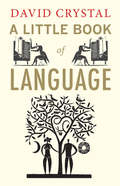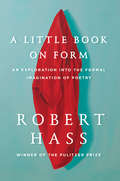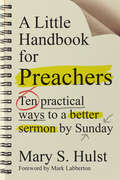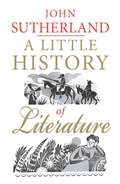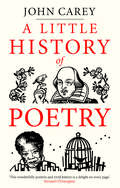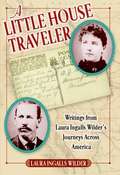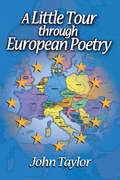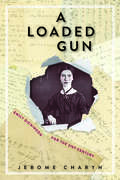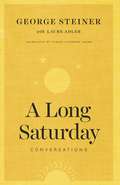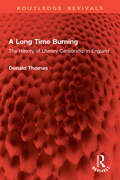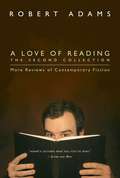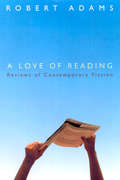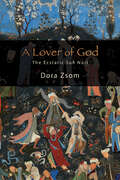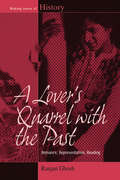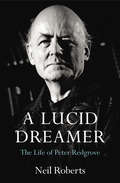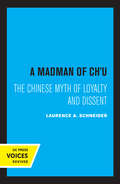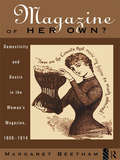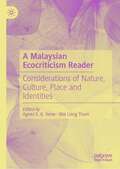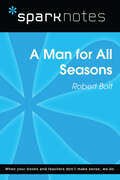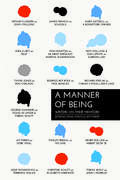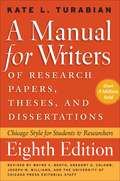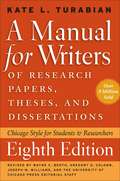- Table View
- List View
A Little Book of Language (Little Histories)
by David CrystalWith a language disappearing every two weeks and neologisms springing up almost daily, an understanding of the origins and currency of language has never seemed more relevant. In this charming volume, a narrative history written explicitly for a young audience, expert linguist David Crystal proves why the story of language deserves retelling. From the first words of an infant to the peculiar modern dialect of text messaging, A Little Book of Language ranges widely, revealing language's myriad intricacies and quirks. In animated fashion, Crystal sheds light on the development of unique linguistic styles, the origins of obscure accents, and the search for the first written word. He discusses the plight of endangered languages, as well as successful cases of linguistic revitalization. Much more than a history, Crystal's work looks forward to the future of language, exploring the effect of technology on our day-to-day reading, writing, and speech. Through enlightening tables, diagrams, and quizzes, as well as Crystal's avuncular and entertaining style, A Little Book of Language will reveal the story of language to be a captivating tale for all ages.
A Little Book on Form: An Exploration into the Formal Imagination of Poetry
by Robert HassAn acute and deeply insightful book of essays exploring poetic form and the role of instinct and imagination within form—from former poet laureate, Pulitzer Prize and National Book Award winning author Robert Hass.Robert Hass—former poet laureate, winner of the National Book Award, and recipient of the Pulitzer Prize—illuminates the formal impulses that underlie great poetry in this sophisticated, graceful, and accessible volume of essays drawn from a series of lectures he delivered at the renowned Iowa Writers’ Workshop.A Little Book on Form brilliantly synthesizes Hass’s formidable gifts as both a poet and a critic and reflects his profound education in the art of poetry. Starting with the exploration of a single line as the basic gesture of a poem, and moving into an examination of the essential expressive gestures that exist inside forms, Hass goes beyond approaching form as a set of traditional rules that precede composition, and instead offers penetrating insight into the true openness and instinctiveness of formal creation.A Little Book on Form is a rousing reexamination of our longest lasting mode of literature from one of our greatest living poets.
A Little Closer to Home: How I Found the Calm After the Storm
by Ginger ZeeIn Ginger Zee's follow-up to the bestselling Natural Disaster, the ABC chief meteorologist takes readers on a much deeper journey of self discovery. <p><p> When Ginger Zee opened her life to readers in Natural Disaster, the response was enormous. She put a very relatable if surprising face on depression and has helped lessen the stigma surrounding mental health issues. But Ginger tells us, Natural Disaster was "Ginger Lite" and only scratched the surface. <p><p> In this moving follow-up, Ginger shares her truest self. She spent most of her life shielding her vulnerabilities from the world all while being a professional people pleaser. Her stormy childhood, her ongoing struggles with crippling depression, her suicide attempts, and many other life experiences will resonate with readers who are likely to see themselves along the way. <p><p> In spite of its serious subject matter, Ginger's positive, life-affirming outlook comes through loud and clear. Written with great heart and quite a bit of humor, Ginger normalizes issues and challenges millions of people face every day. <p><p>A Little Closer to Home will broaden the conversation around mental health at a time we need it more than ever. <p> <b>New York Times Bestseller</b>
A Little Handbook for Preachers: Ten Practical Ways to a Better Sermon by Sunday
by Mark Labberton Mary S. HulstA Little Handbook for Preachers
A Little History of Literature
by John SutherlandThis 'little history' takes on a very big subject: the glorious span of literature from Greek myth to graphic novels, from The Epic of Gilgamesh to Harry Potter. John Sutherland is perfectly suited to the task. He has researched, taught, and written on virtually every area of literature, and his infectious passion for books and reading has defined his own life. Now he guides young readers and the grown-ups in their lives on an entertaining journey 'through the wardrobe' to a greater awareness of how literature from across the world can transport us and help us to make sense of what it means to be human. Sutherland introduces great classics in his own irresistible way, enlivening his offerings with humor as well as learning: Beowulf, Shakespeare, Don Quixote, the Romantics, Dickens, Moby Dick, The Waste Land, Woolf, 1984, and dozens of others. He adds to these a less-expected, personal selection of authors and works, including literature usually considered well below 'serious attention' - from the rude jests of Anglo-Saxon runes to The Da Vinci Code. With masterful digressions into various themes - censorship, narrative tricks, self-publishing, taste, creativity, and madness - Sutherland demonstrates the full depth and intrigue of reading. For younger readers, he offers a proper introduction to literature, promising to interest as much as instruct. For more experienced readers, he promises just the same.
A Little History of Poetry (Little Histories)
by John CareyA vital, engaging, and hugely enjoyable guide to poetry, from ancient times to the present, by one of our greatest champions of literature What is poetry? If music is sound organized in a particular way, poetry is a way of organizing language. It is language made special so that it will be remembered and valued. It does not always work—over the centuries countless thousands of poems have been forgotten. This little history is about some that have not. John Carey tells the stories behind the world&’s greatest poems, from the oldest surviving one written nearly four thousand years ago to those being written today. Carey looks at poets whose works shape our views of the world, such as Dante, Chaucer, Shakespeare, Whitman, and Yeats. He also looks at more recent poets, like Derek Walcott, Marianne Moore, and Maya Angelou, who have started to question what makes a poem "great" in the first place. This little history shines a light on the richness and variation of the world&’s poems—and the elusive quality that makes them all the more enticing.
A Little House Traveler: Writings from Laura Ingalls Wilder's Journeys Across America
by Laura Ingalls Wilder(front flap) Ages 10 up By the mid-1950s Laura Ingalls Wilder's journeys had taken her from Wisconsin to South Dakota, from Missouri to California and back again. She had traveled by wagon, by train, and by car; alone, with her husband, and with her daughter. She had watched the times, seasons, and people change over six decades of traveling. But one thing remained the same: Laura always kept a pencil and paper with her to jot down notes about her experiences. For the first time ever, writings from three of Laura's most memorable trips have been collected in one special omnibus edition featuring historical black-and-white photographs. ON THE WAY HOME recounts her 1894 move with Rose and Almanzo from South Dakota to their new homestead in Mansfield, Missouri. WEST FROM HOME consists of letters from Laura to Almanzo as she traveled to California in 1915 to visit Rose. And previously unpublished materials from Laura and Almanzo's car trip in 1931 now tell the story of their first journey back to DeSmet, the town where Laura grew up, where she met Almanzo, and where they fell in love. Laura's candid sense of humor and keen eye for observation shine through in this wonderful collection of writings about the many places Laura Ingalls Wilder called home. HarperCollinsPublishers
A Little Tour Through European Poetry
by John TaylorThis book is both a sequel to author John Taylor's earlier volume Into the Heart of European Poetry and something different. It is a sequel because this volume expands upon the base of the previous book to include many more European poets. It is different in that it is framed by stories in which the author juxtaposes his personal experiences involving European poetry or European poets as he travels through different countries where the poets have lived or worked. Taylor explores poetry from the Czech Republic, Denmark, Lithuania, Albania, Romania, Turkey, and Portugal, all of which were missing in the previous gathering, analyzes heady verse written in Galician, and presents an important poet born in the Chuvash Republic. His tour through European poetry also adds discoveries from countries whose languages he reads fluently-Italy, Germany (and German-speaking Switzerland), Greece, and France. Taylor's model is Valery Larbaud, to whom his criticism, with its liveliness and analytical clarity, is often compared. Readers will enjoy a renewed dialogue with European poetry, especially in an age when translations are rarely reviewed, present in literary journals, or studied in schools. This book, along with Into the Heart of European Poetry, motivates a dialogue by bringing foreign poetry out of the specialized confines of foreign language departments.
A Loaded Gun
by Jerome Charyn"Remarkable insight . . . [a] unique meditation/investigation. . . . Jerome Charyn the unpredictable, elusive, and enigmatic is a natural match for Emily Dickinson, the quintessence of these." -Joyce Carol Oates, author of Wild Nights! and The Lost LandscapeWe think we know Emily Dickinson: the Belle of Amherst, virginal, reclusive, and possibly mad. But in A Loaded Gun, Jerome Charyn introduces us to a different Emily Dickinson: the fierce, brilliant, and sexually charged poet who wrote: My Life had stood-a Loaded Gun-...Though I than He- may longer liveHe longer must-than I-For I have but the power to kill,Without-the power to die-Through interviews with contemporary scholars, close readings of Dickinson's correspondence and handwritten manuscripts, and a suggestive, newly discovered photograph that is purported to show Dickinson with her lover, Charyn's literary sleuthing reveals the great poet in ways that have only been hinted at previously: as a woman who was deeply philosophical, intensely engaged with the world, attracted to members of both sexes, and able to write poetry that disturbs and delights us today.Jerome Charyn is the author of, most recently, Bitter Bronx: Thirteen Stories, I Am Abraham: A Novel of Lincoln and the Civil War, and The Secret Life of Emily Dickinson: A Novel. He lives in New York.
A Long Saturday: Conversations
by George Steiner Laure AdlerGeorge Steiner is one of the preeminent intellectuals of our time. The Washington Post has declared that no one else “writing on literature can match him as polymath and polyglot, and few can equal the verve and eloquence of his writing,” while the New York Times says of his works that “the erudition is almost as extraordinary as the prose: dense, knowing, allusive.” Reading in many languages, celebrating the survival of high culture in the face of modern barbarisms, Steiner probes the ethics of language and literature with unparalleled grace and authority. A Long Saturday offers intimate insight into the questions that have absorbed him throughout his career. In a stimulating series of conversations, Steiner and journalist Laure Adler discuss a range of topics, including Steiner’s boyhood in Vienna and Paris, his education at the University of Chicago and Harvard, and his early years in academia. Books are a touchstone throughout, but Steiner and Adler’s conversations also range over music, chess, psychoanalysis, the place of Israel in Jewish life, and beyond. Blending thoughts on subjects of broad interest in the humanities—the issue of honoring Richard Wagner and Martin Heidegger in spite of their politics, or Virginia Woolf’s awareness of the novel as a multivocal form, for example—with personal reflections on life and family, Steiner demonstrates why he is considered one of today’s greatest minds. Revealing and exhilarating, A Long Saturday invites readers to pull up a chair and listen in on a conversation with a master.
A Long Time Burning: The History of Literary Censorship in England (Routledge Revivals)
by Donald ThomasCensorship of the written word has proved a constant source for debate and argument. To cut or not to cut is a question with a long and fascinating history. First published in 1969, A Long Time Burning is an account of the political, religious, and moral censorship of literature, in the context of English literary history. It is principally concerned with the evolution of a modern pattern of censorship between the abolition of licensing in 1695 and the late Victorian period. The author outlines the motives and methods of censorship, illustrating these by more detailed discussion of such cases as those involving Edmund Curll, John Wilkes, Thomas Paine, William Hone, Richard Carlile, William Dugdale and Henry Vizetelly. The unofficial trade in banned books and the campaigns of the Proclamation Society; the Society for the Suppression of Vice, and the National Vigilance Association are described with the aid of some previously unpublished material.The book includes an anthology of illustrative material, quoting extracts from publications banned at various times and for various reasons. Pages from such books as Venus in the Cloister are reprinted for the first time in more than two centuries, while the other documents range from the Blasphemy Act of 1698 to a prosecution brought under the Race Relations Act of 1965.
A Long the Riverrun: Selected Essays
by Richard EllmannA splendid collection of literary essays. Ellmann's "Oscar Wilde" was a tremendous critical success, winning both the NBCC and the Pulitzer Prize last year.
A Love of Reading, The Second Collection: More Reviews of Contemporary Fiction
by Robert AdamsFourteen brilliant new reviews fromthe author ofA Love of Reading. Passionate, thought provoking, and witty. A Love of Reading, the Second Collectioncontains 14 new reviews of modern classics from a discriminating, highly entertaining, and prodigiously well-read guide. In a stimulating selection, ranging from Margaret Atwood’sAlias Graceto Zadie Smith’sWhite Teeth, and from Charles Frazier’sCold Mountainto Sheri Holman’sThe Dress Lodger, popular literary critic Robert Adams skilfully interweaves a nimble and enlightening discussion of plot, theme, and characterization with fascinating historical, biographical, and literary context. Adams is repeatedly drawn to the spectacle of less-than-perfect humans making their way in a hostile world, and as a result his reviews are a hugely satisfying mix of rich pathos and abundant humour. In the words of theCalgary Herald, they are “a bibliophile’s dream. ”
A Love of Reading: Reviews of Contemporary Fiction
by Robert AdamsEvery year, Robert Adams prepares a series of five reviews of contemporary novels, to be delivered alone on a theatre stage to sold-out audiences in Toronto and Montreal. In A Love of Reading Adams has now gathered 18 of his most brilliant reviews, from Jack Maggs by Peter Carey and The Poisonwood Bible by Barbara Kingsolver, to A Fine Balance by Rohinton Mistry and Barney's Version by Mordecai Richler. In them he skillfully interweaves a nimble and entertaining discussion of plot, theme, and characterization with fascinating historical, biographical, and literary context. He is repeatedly drawn to the spectacle of less-than-perfect humans making their way in a hostile world, and as a result a review by Robert Adams is almost always a hugely satisfying mix of rich pathos and abundant humour.Famously, Adams reads a book a day, from which he selects only those novels that are truly extraordinary, that have made him see some part of the world or some aspect of the human condition in a new light - because for Adams, the best books always take the reader on a journey, with a destination very distant from the point of departure. It should be not only a journey of discovery - an exploration of the author's vision - but also of risk. By matching one's own vision to that of the author, says Adams, the reader enters an exciting negotiation to produce a new vision of his own. This joint enterprise between reader and writer, the shared risk and the wonder of discovery, is the foundation of A Love of Reading.* For the last six years, Robert Adams has presented an annual series of book reviews to sold out audiences. Eighty per centof Adams' 3,000 subscribers in Toronto and Montreal renew for the following season* This book is a selection of modern classics from a discriminating and entertaining guide* Perfect for reading groups* Quill & Quire, noting the jump in sales of any book reviewed by Adams, has called the phenomenon "The Adams Effect"From the Hardcover edition.
A Lover of God: The Ecstatic Sufi Nūrī (SUNY series in Islam)
by Dora ZsomOne of the so-called ecstatic (or intoxicated) Sufis of Baghdad, Abū Ḥusayn al-Nūrī (d. 907/8) was famous for his quasi-blasphemous utterances and shocking public behavior. He was often enraptured by a passionate love of God that led him to eccentric acts that scandalized both ordinary people and the religious authorities. Besides yielding to divine love and beauty, he would occasionally come near succumbing to bodily temptations and carnal passions. Despite Nūrī’s outrageous behavior, Junayd, the moderate or sober Sufi par excellence, held him in high esteem, kept corresponding with him, and commented upon his controversial ecstatic sayings. This book collects Nūrī’s literary legacy by surveying the sources for his life—poems, sayings, and comments on the Quran, including an exchange of letters between him and Junayd preserved in the Cairo Genizah—and by discussing the authorship of the Stations of the Hearts, which has been widely attributed to Nūrī.
A Lover's Quarrel With The Past
by Ranjan GhoshAlthough not a professional historian, the author raises several issues pertinent to the state of history today. Qualifying the 'non-historian' as an 'able' interventionist in historical studies, the author explores the relationship between history and theory within the current epistemological configurations and refigurations. He asks how history transcends the obsessive 'linguistic' turn, which has been hegemonizing literary/discourse analysis, and focuses greater attention on historical experience and where history stands in relation to our understanding of ethics, religion and the current state of global politics that underlines the manipulation and abuse of history.
A Lucid Dreamer: The Life of Peter Redgrove
by Peter Redgrove Dr Neil RobertsThe work of the poet Peter Redgrove is one of the great unexplored treasures of late twentieth century literature. His prolific output presents an intriguing variety of personae: magician, scientist, lover, psychologist, joker, madman. It is only now, with the publication of his Collected Poems and this biography, that we can see how and why these personae developed - and discover the full depth and range of this visionary writer.Born into an apparently conventional middle-class family that was in reality deeply disturbed, the poet finally emerged: transforming himself from the neurotic, Oedipal young scientist, through a process of mental breakdown, insulin coma therapy, erotic revelation and the discovery of poetic companionship at Cambridge - and particularly his friendship and rivalry with Ted Hughes.Neil Roberts explores the inner story of this emergence, and Redgrove's later development through marriage, family life, the fellowship of the 'Group', alcoholic excess, infidelity and marital breakdown to his triumphant later partnership with Penelope Shuttle. We also discover, for the first time, some darker secrets: his fascination with Aleister Crowley, his damaged and damaging relationship with his father, and the lifelong sexual fetish which he called the 'Game'. Drawing on the poet's intimate journals and correspondence, and interviews with family, friends and colleagues, A Lucid Dreamer tells the exceptionally inward and revealing story of an astonishing creative life.
A Madman of Chu: The Chinese Myth of Loyalty and Dissent (Center for Chinese Studies, Publications)
by Laurence A. SchneiderThis title is part of UC Press's Voices Revived program, which commemorates University of California Press’s mission to seek out and cultivate the brightest minds and give them voice, reach, and impact. Drawing on a backlist dating to 1893, Voices Revived makes high-quality, peer-reviewed scholarship accessible once again using print-on-demand technology. This title was originally published in 1980.
A Magazine of Her Own?: Domesticity and Desire in the Woman's Magazine, 1800-1914
by Margaret BeethamLike the corset, the women's magazines which emerged in the nineteenth century produced a `natural' idea of femininity: the domestic wife; the fashionable woman; the romancing and desirable girl. Their legacy, from agony aunts to fashion plates, are easily traced in their modern counterparts. But do these magazines and their promises empower or disempower their readers? A Magazine of Her Own? is a lively and revealing exploration of this immensely popular form from its beginnings. In fascinating detail Margaret Beetham investigates the desires, images and interpretations of femininity posed by a medium whose readership was and still is almost exclusively female. A Magazine of Her Own is at once a chronological tracing of the history, a collection of intriguing case studies and an intervention into recent debates about gender and sexuality in popular reading. It is a book which anyone who is interested in the unique, influential world of the woman's magazine - students, scholars and general readers alike - will want to read
A Malaysian Ecocriticism Reader: Considerations of Nature, Culture, Place and Identities
by Agnes S. K. Yeow Wai Liang ThamThis collection of essays brings together ecocritical interpretations of Malaysian texts – including fiction, nonfiction, and other media / cultural expressions. It includes original works by environmental activists as well as emerging and established scholars, who collectively analyse various aspects of Malaysian ecological discourse.The contributors address crucial – and often controversial – topics such as local ecological imaginations, wildlife conservation, overdevelopment, postcolonial ecological identities, biopolitics, nature and sexuality, nature and race, the commodification of nature, nature–culture embodiments and entanglements, human–animal relations, waste and materiality, human and other-than-human agency, toxicity and slow violence, self-representations as well as attitudes towards land, nativity and indigeneity, migrancy and diaspora.Readers will gain valuable insights into the ways in which environments and ecological relationships are mediated within this national space, while opening up room to theorise beyond its boundaries.
A Man for All Seasons (SparkNotes Literature Guide Series)
by SparkNotesA Man for All Seasons (SparkNotes Literature Guide) by Robert Bolt Making the reading experience fun! Created by Harvard students for students everywhere, SparkNotes is a new breed of study guide: smarter, better, faster. Geared to what today's students need to know, SparkNotes provides: *Chapter-by-chapter analysis *Explanations of key themes, motifs, and symbols *A review quiz and essay topicsLively and accessible, these guides are perfect for late-night studying and writing papers
A Manner of Being: Writers on Their Mentors
by Jeff Parker Annie LiontasWhat do the punk singer Henry Rollins, the Guatemalan writer Rodrigo Rey Rosa, the American authors Tobias Wolff, Tayari Jones, and George Saunders, the Canadian writer Sheila Heti, and the Russian poet Polina Barskova have in common? At some point they all studied the art of writing deeply with someone. The nearly seventy short essays in A Manner of Being, by some of the best contemporary writers from around the world, pay homage to mentors—the writers, teachers, nannies, and sages—who enlighten, push, encourage, and sometimes hurt, fail, and limit their protégés. There are mentors encountered in the schoolhouse and on farms, in NYC and in MFA programs; mentors who show up exactly when needed, offering comfort, a steadying hand, a commiseration, a dose of tough love. This collection is rich with anecdotes from the heartfelt to the salacious, gems of writing advice, and guidance for how to live the writing life in a world that all too often doesn’t care whether you write or not. Each contribution is intimate and distinct—yet a common theme is that mentors model a manner of being. Selections include: Arthur Flowers on John O’Killens James Franco on Harmony Korine Mary Gaitskill on an Ann Arbor bookstore owner Noy Holland and Sam Lipsyte on Gordon Lish Tayari Jones on Ron Carlson Henry Rollins on Hubert Selby Jr. Rodrigo Rey Rosa on Paul Bowles George Saunders on Douglas Unger and Tobias Wolff Christine Schutt on Elizabeth Hardwick Tobias Wolff on John L’Heureux . . . and many more
A Manual for Writers of Research Papers, Theses, and Dissertations
by Kate L. TurabianA little more than seventy-five years ago, Kate L. Turabian drafted a set of guidelines to help students understand how to write, cite, and formally submit research writing. Seven editions and more than nine million copies later, the name Turabian has become synonymous with best practices in research writing and style. Her Manual for Writers continues to be the gold standard for generations of college and graduate students in virtually all academic disciplines. Now in its eighth edition, A Manual for Writers of Research Papers, Theses, and Dissertations has been fully revised to meet the needs of today’s writers and researchers. The Manual retains its familiar three-part structure, beginning with an overview of the steps in the research and writing process, including formulating questions, reading critically, building arguments, and revising drafts. Part II provides an overview of citation practices with detailed information on the two main scholarly citation styles (notes-bibliography and author-date), an array of source types with contemporary examples, and detailed guidance on citing online resources. The final section treats all matters of editorial style, with advice on punctuation, capitalization, spelling, abbreviations, table formatting, and the use of quotations. Style and citation recommendations have been revised throughout to reflect the sixteenth edition of The Chicago Manual of Style. With an appendix on paper format and submission that has been vetted by dissertation officials from across the country and a bibliography with the most up-to-date listing of critical resources available, A Manual for Writers remains the essential resource for students and their teachers.
A Manual for Writers of Research Papers, Theses, and Dissertations 8th Edition
by Kate L. TurabianA little more than seventy-five years ago, Kate L. Turabian drafted a set of guidelines to help students understand how to write, cite, and formally submit research writing. Seven editions and more than nine million copies later, the name Turabian has become synonymous with best practices in research writing and style. Her Manual for Writers continues to be the gold standard for generations of college and graduate students in virtually all academic disciplines. Now in its eighth edition, A Manual for Writers of Research Papers, Theses, and Dissertations has been fully revised to meet the needs of today's writers and researchers. The Manual retains its familiar three-part structure, beginning with an overview of the steps in the research and writing process, including formulating questions, reading critically, building arguments, and revising drafts. Part II provides an overview of citation practices with detailed information on the two main scholarly citation styles (notes-bibliography and author-date), an array of source types with contemporary examples, and detailed guidance on citing online resources. The final section treats all matters of editorial style, with advice on punctuation, capitalization, spelling, abbreviations, table formatting, and the use of quotations. Style and citation recommendations have been revised throughout to reflect the sixteenth edition of The Chicago Manual of Style. With an appendix on paper format and submission that has been vetted by dissertation officials from across the country and a bibliography with the most up-to-date listing of critical resources available, A Manual for Writers remains the essential resource for students and their teachers.
A Manual for Writers of Research Papers, Theses, and Dissertations, Eighth Edition: Chicago Style for Students and Researchers
by Joseph M. Williams Kate L. Turabian Wayne C. Booth Gregory G. Colomb Wayne C. University of Chicago Press StaffA little more than seventy-five years ago, Kate L. Turabian drafted a set of guidelines to help students understand how to write, cite, and formally submit research writing. Seven editions and more than nine million copies later, the name Turabian has become synonymous with best practices in research writing and style. Her Manual for Writers continues to be the gold standard for generations of college and graduate students in virtually all academic disciplines. Now in its eighth edition, A Manual for Writers of Research Papers, Theses, and Dissertations has been fully revised to meet the needs of today’s writers and researchers. The Manual retains its familiar three-part structure, beginning with an overview of the steps in the research and writing process, including formulating questions, reading critically, building arguments, and revising drafts. Part II provides an overview of citation practices with detailed information on the two main scholarly citation styles (notes-bibliography and author-date), an array of source types with contemporary examples, and detailed guidance on citing online resources. The final section treats all matters of editorial style, with advice on punctuation, capitalization, spelling, abbreviations, table formatting, and the use of quotations. Style and citation recommendations have been revised throughout to reflect the sixteenth edition of The Chicago Manual of Style. With an appendix on paper format and submission that has been vetted by dissertation officials from across the country and a bibliography with the most up-to-date listing of critical resources available, A Manual for Writers remains the essential resource for students and their teachers.
